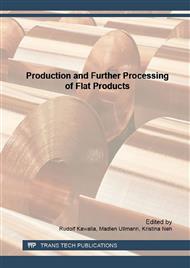[1]
C. Bergenstof, P. Nielsen, Leisner, A. Horsewell: On texture formation of chromium electrodeposits., J. Appl. Electrochem., 28 (1998) 141–150.
Google Scholar
[2]
Müll, K.: Die Prozess- und Verfahrenstechnik von TOPOCROM®. http: /www. topocrom. com/content/pdf/Artikel_Verfahren_k_muell. pdf (18. 11. 2015).
Google Scholar
[3]
Ritterbach, B.: Qualitätsregelkreis zur Erzeugung definierter Feinblechrauheiten mit verschiedenen Texturierverfahren., Fortschrittsberichte VDI, Nr. 517 (1998).
Google Scholar
[4]
Zimnik, W., Ritterbach, B., Müll, K.: PRETEX - Ein neues Verfahren zur Erzeugung texturierter Feinblechoberflächen für höchste Ansprüche., Stahl und Eisen, 118 (1998) 75-80.
Google Scholar
[5]
Kijima, Hideo: Influence of roll radius on roughness transfer in skin-pass rolling of steel strip., J. Mater. Process. Technol., 214 (2014) 1111– 1119.
DOI: 10.1016/j.jmatprotec.2013.12.019
Google Scholar
[6]
Wentink, D.J., Matthews D., Appelman, N.M., Toose, E.M.: A generic model for surface texture development, wear and roughness transfer in skin pass rolling., Wear, 328-329 (2015) 167–176.
DOI: 10.1016/j.wear.2015.02.015
Google Scholar
[7]
Kijima, Hideo: An experimental investigation on the influence of lubrication on roughness transfer in skin-pass rolling of steel strip., J. Mater. Process. Technol., 225 (2015) 1–8.
DOI: 10.1016/j.jmatprotec.2015.05.023
Google Scholar
[8]
Kijima, Hideo, Bay, Niels: Skin-pass rolling I - Studies on roughness transfer and elongation under pure normal loading., Int. J. Mach. Tool. Man., 48 (2008) 1313– 1317.
DOI: 10.1016/j.ijmachtools.2008.06.005
Google Scholar
[9]
Kijima, Hideo, Bay, Niels: Skin-pass rolling II—Studies of roughness transfer under combined normal and tangential loading., Int. J. Mach. Tool. Man., 48 (2008) 1308 – 1312.
DOI: 10.1016/j.ijmachtools.2008.06.006
Google Scholar
[10]
Deutscher, O.: Methods for attaining particular roughness on cold rolled strip., Iron Steel Eng. 74 (1997), 35 – 40.
Google Scholar
[11]
Steinhoff, K., Bünten, R., Rasp, W., Kopp, R., Pawelski, O.: Development of a model for the simulation of the transfer of surface structure in the temper-rolling process. Steel Res. 66 (1995) 520–525.
DOI: 10.1002/srin.199501165
Google Scholar
[12]
ISO 25178: Geometric Product Specifications (GPS) – Surface texture: areal.
Google Scholar
[13]
Wilson, T.: Confocal microscopy, Academic Press Inc. (1990).
Google Scholar
[14]
Ballard, D. H.: Generalizing the Hough Transform to Detect Arbitrary Shapes, Pattern Recognition, 13 (1981) 111–122.
DOI: 10.1016/0031-3203(81)90009-1
Google Scholar


